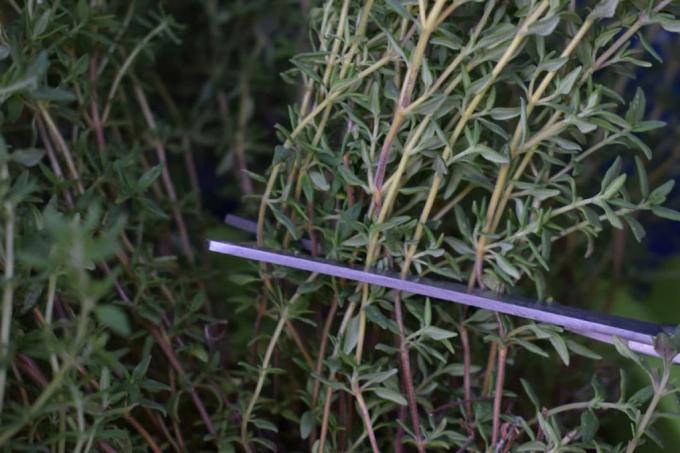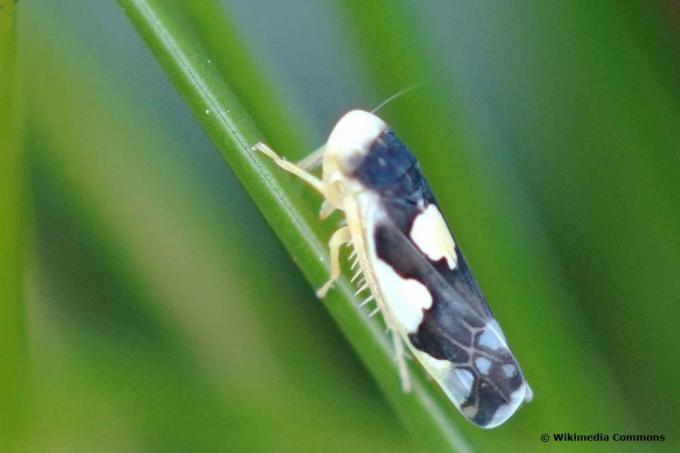
table of contents
- Cultivation
- Location
- floor
- Bucket culture
- to water
- Fertilize
- Cut
- Overwinter
- Diseases
- Pests
- frequently asked Questions
Thyme is one of the most popular culinary herbs. The plant that remains small has a lot of potential. It can be used as a medicinal herb, bee pasture, fragrant plant and ground cover. We give tips on cultivation and care.
In a nutshell
- Origin: Mediterranean, Africa, Asia
- Synonyms: Quendel, Immenkraut, Tripe, garden thyme.
- Use: spice, medicinal herb, bee pasture
- Propagation: sowing, dividing and cuttings
- Maintenance: easy
Cultivation
Thyme is propagated by seeds, plant cuttings or division of the plant.

Propagation by seeds
Garden thyme can be propagated well by sowing. After flowering, collect the seeds. To do this, carefully cut off the faded flowers. Tie small bouquets, put a paper bag over them and hang up the thyme bouquets. The small seeds fall into the paper bag.
Sow the herb in spring. Flat dishes are suitable for cultivation. The germination temperature is 15 degrees Celsius. Thyme is a light germ. This means that the seeds should only be very lightly covered with soil.
Instructions:
- Mix potting soil with some sand.
- Put the mixture in shallow bowls to grow.
- Sow thyme seeds into it.
- Gently press the seeds with a rolling pin.
- Lightly spray the seeds with water. Use a spray bottle.
- Cover the bowls with plastic wrap or a sheet of glass.
The little plants can be seen two weeks later. Prick these out after four to five weeks. Put the young plants in small pots. One month later, around the end of May, you can plant the small plants outdoors in a sunny, warm place. Water the young plants carefully after planting. In the first few weeks, be careful not to let them dry out. When the garden thyme has grown well, it no longer needs watering.
Multiplication by division
The easiest way to propagate thyme is by dividing it.
Instructions:
- Dig up part of the plant. Use a sharp, clean spade.
- Put the new plant part in a warm place with some compost soil.
- Give her a few extra waterings until she is well grown.

Propagation by cuttings
Propagation by cuttings is often used for thyme.
Instructions:
- Cut off one shoot with a clean, sharp knife.
- Put this in a glass with water.
- When the cutting has taken root, plant it in compost mixed with sand.
- Water the cutting.
Tip: You can also insert the cutting directly into sandy substrate and plant in a sunny location.
Location
Thyme comes from the Mediterranean region. It is also common in Africa and Asia.
All thyme species need a sunny, warm spot in the garden. They feel most comfortable in rock gardens and on dry stone walls.
floor
All species of Quendel are robust and have no special demands on the quality of the soil. They thrive well on dry, well-drained, slightly sandy and nutrient-poor substrate. In more humid locations, the herb needs a drainage made of gravel, because the garden plant does not tolerate waterlogging.

Bucket culture
Thyme plants are suitable for cultivation in tubs and pots. Plant the culinary herbs together with rosemary, Sage and fennel and enjoy the spicy scent on the balcony or terrace. You can also grow a flower pot with thymus on the windowsill for a short time. However, the plant prefers a sunny and airy location outdoors.
to water
When thyme plants have grown well in the garden, you no longer need to worry about the water supply. The robust herb does not need additional watering even in dry summers. Potted plants should only be poured when the substrate is dry. Make sure that the water can drain well. Waterlogging is not tolerated.
Fertilize
Thyme works without additional fertilization. Give the plants some compost in the spring. Compost works for a long time and slowly transfers the nutrients into the soil.
Cut
Quendel grows quickly and forms woody shoots. A topiary in spring promotes branching, prevents the formation of long, unsightly shoots and enables the design of the ground cover. Regularly remove a few shoots from the plant for seasoning. This refines your food and stimulates new growth.
Attention: Quendel is hardy. Only the freshly cut shoots are sensitive. If night frosts appear after the cut in spring, protect the plants with a fleece.

Overwinter
Garden thyme overwinters outdoors without protection. Potted plants on the terrace should be placed on a styrofoam plate and wrapped in a jute sack. You can safely bring the potted plants in the basement or a garage over the winter on an insulating underlay with a fleece cover.
Diseases
Thyme is an easy-care, robust plant. Fungal diseases such as powdery mildew and gray mold occur rarely. As a preventive measure, water the plants with a fortifying field horsetail broth.
Pests
If the robust garden herb is attacked by pests, nitrogen fertilization can often be identified as the cause. Thyme needs lean, nutrient-poor soil. Nitrogen fertilization damages the plant and makes it susceptible to pests and diseases.
Every now and then the following pests appear on the garden thyme:
- Aphids
- Cicadas
- Japanese beetle
We recommend spraying with nettle stock against aphids. Put two handfuls of nettle shoots in two liters of water. Let the mixture stand for twelve hours. Take a spray bottle and wet the infested plants with the brew.
Radical pruning after the harvest in autumn helps against cicadas. Neem supplements and yellow bars promise a remedy. Regularly remove weeds for prevention and choose a cicada-free location for replanting thyme.

Note: The better the living conditions for ladybugs, parasitic wasps and other beneficial insects in your garden, the less pest infestation will occur.
The 8 to 12 millimeter long Japanese beetle can cause great damage to crops. It belongs to the scarab beetle family and looks similar to the June beetle. Japanese beetles will eat the thyme leaves until only the stems are left. Nematodes can be used against the grubs of the Japanese beetles. Make sure to collect the beetles from your plants and destroy them.
frequently asked Questions
All types of thyme prefer nutrient-poor, calcareous soils. The high pH value often means that plants can no longer absorb enough iron. The yellow color of the young leaves and the conspicuously green leaf veins are typical symptoms of iron deficiency. A simple way to lower the pH and ensure the iron supply is to add compost. Alternatively, you can put coffee grounds on the beds.
Plant the garden herbs in herb beds together with savory, tarragon, rosemary, basil and sage. Marjoram is unsuitable as a planting partner.
Put thyme in between lettuce, cabbage or strawberries to protect against snails. By the way, thyme's best neighbors are other types of thyme. In combination, they look very decorative in pots and window boxes. The plants bloom from June to August with white, red, purple or pink flowers. Different species create an enchanting sea of flowers, which spread an aromatic scent.
We recommend cutting garden thyme by two thirds in spring. Use clean, sharp scissors.



